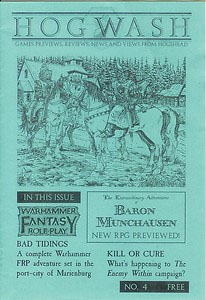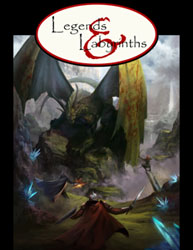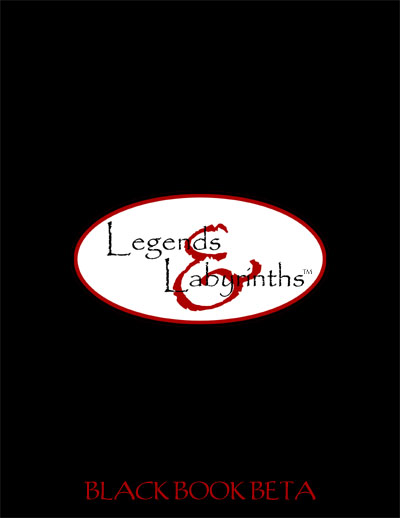Tagline: Hogshead is quickly becoming one of those companies I continually look to because of their consistent high quality. Hogswash, their sorta annual “newsletter/fanzine/thing”, not only helps you to keep an eye on them, but also has some pretty solid material in it.
 I got subscribed to Hogwash one day while I was perusing Hogshead’s website. It wasn’t particularly difficult – all I had to do was drop them an e-mail with my home address in it and, before I knew it, I had the current issue of Hogwash (#4) sitting in my mailbox. Hogwash, you see, is a “newsletter/fanzine/thing” for Hogshead – it’s self-promotional content is rather high, so its distributed freely.
I got subscribed to Hogwash one day while I was perusing Hogshead’s website. It wasn’t particularly difficult – all I had to do was drop them an e-mail with my home address in it and, before I knew it, I had the current issue of Hogwash (#4) sitting in my mailbox. Hogwash, you see, is a “newsletter/fanzine/thing” for Hogshead – it’s self-promotional content is rather high, so its distributed freely.
So why am I reviewing a “newsletter/fanzine/thing”? Because, having read it, I want to encourage all of you to drop Hogshead a line and get subscribed to it. And why do I want you to do that? Basically two reasons.
First, Hogshead tosses interesting tidbits of free game-stuff into each issue (mini-modules, monster write-ups, etc.). This is the “substance” of the issue, and it’s quality makes it well worth the handful of minutes it will take you to read through it. Its more than worth the price (since there is no price).
Second, Hogshead is quickly setting itself up as one hell of a fine game company. It’s finally beginning to produce original material for their licensed Warhammer Fantasy Roleplaying line of products (having gotten almost all of the original line back in print), and the stuff that’s coming out looks like its going to be absolutely fantastic. On top of that they’ve released The Extraordinary Adventures of Baron Munchausen (which I’ve reviewed elsewhere). In the near future they’ll be releasing Violence (by anonymous author who we all know) and Puppetland (by John Tynes), among other projects. Hogshead is hot, and Hogwash is an excellent way to keep an eye on the company.
Let’s take Hogwash 4 as an example. It was released in August 1998 (but I didn’t get it until just a couple of months ago, when I signed up). If you had gotten it in August 1998 you would have been treated to a sneak preview of The Extraordinary Adventures of Baron Munchausen, Marienburg: Sold Down the River, and the Enemy Within campaign.
The main substance of the issue is a mini-module for WFRP, Bad Tidings, set in Marienburg and written by James Wallis. For eight half-pages, James packs in a lot of plot and background (involving a murder mystery, a Chaos cult, and even a handful of interesting adventure seeds). Very nicely done, and well worth the absolute nothing you paid for it (since, even if you don’t like the world of WFRP, it’s easily adaptable to any fantasy campaign).
In addition an “exclusive interview” discussing The Extraordinary Adventures of Baron Munchausen (which is as cleverly done as the game itself), and a two page article explaining the changes which Hogshead will be making to the legendary Enemy Within campaign. Plus you get the “Not the WFRP FAQ” FAQ, and a rough pencil preview of the cover to Marienburg: Sold Down the River.
All in all, I strongly advise signing up for a free subscription.
Style: 3
Substance: 4
Author: James Wallis
Company/Publisher: Hogshead Publishing, Ltd.
Cost: Free!
Page count: 16
ISBN: n/a
Originally Posted: 1999/07/26
I really miss Hogshead. They were daring and clever and James Wallis was always marvelously kind to me as both a reviewer and a freelancer. James’ is still around, of course. You can find his blog over here, and he continues to share marvelous games with us on an entirely-too-infrequent basis.
For an explanation of where these reviews came from and why you can no longer find them at RPGNet, click here.













